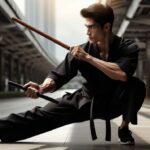Introduction:
Table of Contents
Kung Fu, an ancient Chinese martial art, is renowned for its diverse range of techniques, from graceful forms to powerful strikes. However, beyond the basics lies a realm of advanced techniques that require dedication, skill, and discipline to master. In this article, we delve into seven advanced Kung Fu techniques that every martial artist should aspire to master.
Advanced Kung Fu Techniques
Iron Palm Technique:
The Iron Palm technique is a hallmark of advanced Kung Fu training, focusing on strengthening the hands and fingers to deliver devastating strikes. Practitioners undergo rigorous conditioning exercises, including striking sandbags filled with gravel or iron shot, to toughen their palms. This technique enables martial artists to deliver powerful blows capable of breaking boards, bricks, or even bones with precision and control.

Drunken Boxing (Zui Quan):
Drunken Boxing, or Zui Quan, is a unique Kung Fu style that mimics the movements of a drunkard in combat. Despite its seemingly erratic and unorthodox movements, Drunken Boxing requires exceptional balance, coordination, and timing. Practitioners utilize swaying, stumbling, and feigned vulnerability to confound opponents, making it challenging to predict their next move. This deceptive style emphasizes fluidity and unpredictability, allowing martial artists to exploit openings and counterattacks effectively.
Eagle Claw Technique (Ying Zhao Shou):
The Eagle Claw Technique, also known as Ying Zhao Shou, is a sophisticated Kung Fu style characterized by its swift, grasping movements reminiscent of an eagle’s talons. This technique focuses on targeting vital pressure points and joints with precision strikes and locks. Practitioners develop strong gripping strength and dexterity, enabling them to immobilize opponents and control the flow of combat effortlessly. The Eagle Claw Technique emphasizes speed, agility, and adaptability, making it a formidable skill in close-quarters combat.
Dim Mak (Death Touch):
Dim Mak, commonly referred to as the Death Touch, is a secretive and controversial aspect of advanced Kung Fu training. This technique involves striking specific pressure points on the body with pinpoint accuracy to disrupt the flow of Qi (vital energy) and induce incapacitating or lethal effects. Mastery of Dim Mak requires extensive knowledge of human anatomy, meridian points, and precise striking techniques. While its effectiveness is debated, Dim Mak remains a subject of fascination and intrigue in martial arts circles.
Five Animals Kung Fu (Wu Xing Quan):
Five Animals Kung Fu, or Wu Xing Quan, is a dynamic Kung Fu style inspired by the movements and characteristics of five animals: Tiger, Crane, Leopard, Snake, and Dragon. Each animal represents a unique fighting strategy and set of techniques, ranging from the powerful strikes of the Tiger to the evasive movements of the Snake. Practitioners emulate the agility, strength, and adaptability of these animals in combat, incorporating their distinctive techniques into a seamless and fluid fighting style.
Pressure Point Fighting (Dian Xue):
Pressure Point Fighting, or Dian Xue, is a specialized aspect of advanced Kung Fu training focused on targeting vulnerable pressure points on the body to incapacitate opponents. By applying precise strikes or manipulation techniques to specific acupoints, practitioners can disrupt the body’s natural functions, causing pain, paralysis, or unconsciousness. Dian Xue emphasizes sensitivity, timing, and accuracy, allowing martial artists to neutralize threats swiftly and efficiently.
Qi Gong (Energy Cultivation):
Qi Gong, an integral component of traditional Chinese martial arts, is a holistic practice that involves cultivating and harnessing Qi (vital energy) for health, longevity, and combat efficacy. Through breath control, meditation, and physical exercises, practitioners enhance their internal energy circulation, strengthen their body’s resilience, and sharpen their focus and intent. Qi Gong complements external Kung Fu techniques, providing martial artists with a foundation of inner strength and vitality to excel in combat and daily life.

Conclusion:
Advanced Kung Fu techniques encompass a diverse array of skills, from powerful strikes to elusive maneuvers, each requiring dedication, discipline, and perseverance to master. Whether mastering the Iron Palm or delving into the secrets of Dim Mak, martial artists embark on a lifelong journey of self-discovery and mastery through advanced Kung Fu training.
FAQs:
- What is the significance of mastering advanced Kung Fu techniques? Mastering advanced Kung Fu techniques not only enhances combat proficiency but also cultivates mental discipline, physical fitness, and spiritual growth.
- Are advanced Kung Fu techniques suitable for beginners? Advanced Kung Fu techniques require a solid foundation in basic skills and considerable training experience. Beginners should focus on mastering fundamental techniques before advancing to more complex techniques.
- How long does it take to master advanced Kung Fu techniques? The time required to master advanced Kung Fu techniques varies depending on individual dedication, aptitude, and training frequency. It typically takes several years of consistent practice under the guidance of a qualified instructor.
- Are advanced Kung Fu techniques practical for self-defense? Advanced Kung Fu techniques can be practical for self-defense in certain situations, but effective self-defense also requires situational awareness, de-escalation skills, and knowledge of legal implications.
- Can anyone learn advanced Kung Fu techniques? While advanced Kung Fu techniques require dedication and discipline, they are accessible to individuals of all ages and fitness levels with proper instruction and commitment to training.


